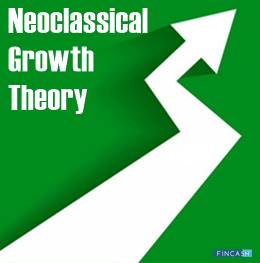What is Neoclassical Growth Theory?
Neoclassical growth theory refers to an economic model that defines that steady Economic Growth results from three binding forces – labour, Capital, and technology. While an Economy may have limited sources in terms of labour and capital, technology can extensively contribute to its growth.

The National Bureau of Economic Research gives credit to Robert Solow and Trevor Swan for developing and introducing the neoclassical growth theory, which is also sometimes referred to as the Solow and Swan model.
What does the Neoclassical Growth Theory Postulate?
According to the neoclassical growth theory, a temporary or short-term equilibrium results from a proportional capital size and active labour in the production function. The theory also argues that technology significantly influences the economy as it cannot continue to grow without technological advances.
Neoclassical growth theory outlines three factors necessary for economic growth. However, the theory explains that short term equilibrium is different from long-term equilibrium and does not require any of the three given factors.
Production Function of Neoclassical Growth Theory
The growth theory states that capital accumulation within an economy and how people use that capital is important to determine economic growth. Moreover, the relationship between capital and labour in an economy defines its total output.
The theory further claims that technology augments labour productivity, increasing the total output through improved labour Efficiency. Therefore, the production function of neoclassical growth theory is used to estimate the growth and equilibrium of an economy.
The formula for estimating the growth is:
Y = AF (K, L)
where:
- Y – Gross Domestic Product (GDP) of a country
- K – share of capital
- L – the number of unskilled labour in an economy
- A – level of technology
However, because of the relationship between labour and technology, an economy's production function is often re-stated as Y = F (K, AL). This presents that technology is labour augmenting and workers productivity or efficiency depends on the level of technology.
Talk to our investment specialist
Neoclassical Growth Theory Assumptions
The neoclassical growth theory rests upon three assumptions including:
Capital subject to diminishing returns: One of the important assumptions of this model is that capital (K) is subject to diminishing returns given that it's a closed economy.
The steady-state of the economy: The diminishing returns lead to a slower growth rate, converting the economy into a steady-state economy where the economy remains static or in a relatively constant stage.
Impact on the total output: The impact on the last unit of the accumulated capital will be less than the other units.
Neoclassical Growth Theory Vs. Endogenous Growth Theory
Endogenous growth theory exerts that economic growth is a result of endogenous forces rather than exogenous ones. The theory suggests that internal processes generate economic growth within a system.
The endogenous growth theory contrasts with the traditional neoclassical theory, which argues that external factors like technological advancements, etc., play a crucial role in the growth of an economy. Although the neoclassical growth model is rich analytically, it fails to explain the steady-state growth in per capita values of output.
Conclusion
The neoclassical growth model implies that the long term growth rate of an economy is determined by technological progress or regress. More so, it also implies that if the same technology is available to all the countries, each country will converge to a growth rate that will only vary from that of another country by the difference in their population growth rate.
All efforts have been made to ensure the information provided here is accurate. However, no guarantees are made regarding correctness of data. Please verify with scheme information document before making any investment.












